 ?Mathematical formulae have been encoded as MathML and are displayed in this HTML version using MathJax in order to improve their display. Uncheck the box to turn MathJax off. This feature requires Javascript. Click on a formula to zoom.
?Mathematical formulae have been encoded as MathML and are displayed in this HTML version using MathJax in order to improve their display. Uncheck the box to turn MathJax off. This feature requires Javascript. Click on a formula to zoom.Abstract
In this research, we constructed the exact travelling and solitary wave solutions of the Kudryashov–Sinelshchikov (KS) equation by implementing the modified mathematical method. The KS equation describe the phenomena of pressure waves in mixtures liquid-gas bubbles under the consideration of heat transfer and viscosity. Our new obtained solutions in the shape of hyperbolic, trigonometric, elliptic functions including dark, bright, singular, combined, kink wave solitons, travelling wave, solitary wave and periodic wave. We showed the physical interpretation of obtained solutions by three-dimensional graphically. These new constructed solutions play vital role in mathematical physics, optical fiber, plasma physics and other various branches of applied sciences.
1. Introduction
Kudryashov and Sinelshchikov (KS) in (2010) first time introduced a nonlinear evolution equation with the help of theoretical and experimental work [Citation1]. The KS equation describe the phenomena of pressure waves in mixtures liquid-gas bubbles under the consideration of heat transfer and viscosity. The KS equation given [Citation1], as
(1)
(1) In Equation (Equation1
(1)
(1) ),
is a function which denote to density, heat transfer and viscosity models,
are real constant parameters. If
, then Equation (Equation1
(1)
(1) ), change into Korteweg-de Vries equation [Citation2], as
(2)
(2) If
then Equation (Equation1
(1)
(1) ), reduced into Korteweg-de Vries Burgers equation [Citation3], as
(3)
(3) The Equation (Equation1
(1)
(1) ), is the general form of KdV equation and KdVB equation. When
then Equation (Equation1
(1)
(1) ), obtain [Citation4], as
(4)
(4) The author using the modification form of truncated expansion technique to investigate the solitary wave solutions of Equation (Equation4
(4)
(4) ), under the following condition
[Citation4]. Recently, many researchers found different types of solutions of KS equation by applying different techniques at different conditions of parameters, as in these references [Citation5–16].
In the last few decades, a lots of research have been done to determine the exact solutions of nonlinear evolution equations (NLEEs). The investigations of exact solutions of NLEEs have a great deal to know the structure, provide better information and its applications. Therefore, to calculate the exact and solitary solutions of nonlinear partial differential equations (NLPDEs), many researchers and mathematician introduced a lot of methods. Such as, Hirota bilinear method, Exp-function technique, Jacobian elliptic method, Trial equation method, extended simple equation method, exp -expansion method, Backlund transformation, improved extended Fan-Subequation method, Darboux transformation, sinh-cosh method, sech-tanh method, extended direct algebraic method, extended auxiliary equation mapping method, improved F-expansion method [Citation17–29] and many researcher in applications of mathematical methods [Citation30–42].
In this current work, we investigated the exact travelling and solitary solutions of nonlinear KS equation by implementing the modified mathematical method [Citation43–50].
This research work is arranged as follows, we explain the introduction in Section 1. We describe the proposed technique in Section 2. We implemented the described technique on KS equation and found the exact travelling and solitary solutions in Section 3. This work end at conclusion in Section 4.
2. Description of proposed method
Here we describe the main future of the modified mathematical technique for finding the solutions of nonlinear partial differential equations (PDEs). We consider the general form of nonlinear PDEs as
(5)
(5) Where Q denote to polynomial function of
and their derivatives. We explain the features of modified mathematical technique as
We consider the transformations of travelling wave as
(6)
(6) In Equation (Equation6
(6)
(6) ), λ is the wave frequency. We obtain the ODE of Equation (Equation5
(5)
(5) ), as
(7)
(7) In Equation (Equation7
(7)
(7) ), R denote to polynomial function in
and their derivative.
We consider the trial solution of Equation (Equation7
(7)
(7) ), as
(8)
(8) Here (
are constants which calculate later, the derivatives of
satisfy the following auxiliary equation
(9)
(9) In Equation (Equation9
(9)
(9) ),
are real constants which are found later.
We balance the terms of nonlinear and derivative of higher order in Equation (Equation7
(7)
(7) ), determined N of Equation (Equation8
(8)
(8) ).
Putting Equation (Equation8
(8)
(8) ) in Equation (Equation9
(9)
(9) ) and collecting every coefficients of
then every coefficients make zero and get a system of equation, solve these system of equations using any computer software, the values of these parameters
are found.
Substituting parameters values which are obtained and
in Equation (Equation9
(9)
(9) ), then we obtain the required solutions of Equation (Equation5
(5)
(5) ).
3. KS equation
Here we apply the described technique to construct the solitary wave solutions for the KS equation.
(10)
(10) We apply transformation of the wave
(11)
(11) Substituting Equation (Equation11
(11)
(11) ) in Equation (Equation10
(10)
(10) ) and integrating once w.r to ζ with zero integration constant, we obtain the following:
(12)
(12) We balance the term of nonlinear and derivative of higher order in Equation (Equation12
(12)
(12) ), we get
Trial solution of Equation (Equation12
(12)
(12) ), take as
(13)
(13) Substituting Equation (Equation13
(13)
(13) ) in Equation (Equation12
(12)
(12) ) and collect every coefficients of
compare every coefficients to zero. We obtain a system of equations. These system of equations solve by using the computer software Mathematica, the values of constants obtained are as follows:
Case-I
(14)
(14)
Substituting Equation (Equation14(14)
(14) ) in Equation (Equation13
(13)
(13) ), we get the solutions of Equation (Equation10
(10)
(10) ) as
(15)
(15)
(16)
(16)
(17)
(17) Case-II
(18)
(18) Substituting Equation (Equation18
(18)
(18) ) in Equation (Equation13
(13)
(13) ), we obtain the solutions of Equation (Equation10
(10)
(10) ) as
(19)
(19)
(20)
(20)
(21)
(21)
Case-III
(22)
(22) Substituting Equation (Equation22
(22)
(22) ) in Equation (Equation13
(13)
(13) ), we get the solutions of Equation (Equation10
(10)
(10) ) as
(23)
(23)
(24)
(24)
(25)
(25)
Case-IV
(26)
(26) Substituting Equation (Equation26
(26)
(26) ) in Equation (Equation13
(13)
(13) ), the solutions of Equation (Equation10
(10)
(10) ) are given as
(27)
(27)
(28)
(28)
(29)
(29)
Case-V
(30)
(30) Substituting Equation (Equation30
(30)
(30) ) in Equation (Equation13
(13)
(13) ), we obtain the solutions of Equation (Equation10
(10)
(10) ) as
(31)
(31)
(32)
(32)
(33)
(33)
Case-VI
(34)
(34) Substituting Equation (Equation34
(34)
(34) ) in Equation (Equation13
(13)
(13) ), the solutions of Equation (Equation10
(10)
(10) ) are given as
(35)
(35)
(36)
(36)
(37)
(37) Case-VII
(38)
(38) Substituting Equation (Equation38
(38)
(38) ) in Equation (Equation13
(13)
(13) ), the solutions of Equation (Equation10
(10)
(10) ) are obtained as
(39)
(39)
(40)
(40)
(41)
(41)
4. Results and discussion
Many researchers determined different types of solutions of KS equation by applying different techniques. In this recent work, we have found new and more general exact travelling and solitary wave solutions, the important thing in this study is the trial solution of Equation (Equation8(8)
(8) ) uses the range of four parameters that have different structures. The values of constant parameters
are collected by applying the Mathematica, then Equation (Equation9
(9)
(9) ) has different types of solutions which are hyperbolic, rational and trigonometric functions. As a result, are obtained new families of exact travelling and solitary wave solutions with the help of this powerful technique. Now we discuss the differences and similarities of our new obtained solutions with already that have been found in the past literature by using different techniques.
In previous literature, many authors have been determined various types of solutions of KS equation such as elliptic, trigonometric, hyperbolic, rational functions including dark, bright, kink, anti-kink, periodic wave solutions with the help of modified truncated expansion method, dynamical system, bifurcation technique, backlund transformation, lie symmetry analysis, F-expansion method, improved subequation method, the -expansion method [Citation5–16]. But our obtained solutions have different structures in the shape of dark, bright, singular, combined, kink wave solitons, periodic solitary wave, traveling wave (see Figures ).
Figure 1. (a) Dark soliton solution for Equation (Equation15(15)
(15) ) and (b) bright soliton solution for Equation (Equation16
(16)
(16) ).

Figure 2. (a) Bright soliton solution for Equation (Equation17(17)
(17) ), and (b) dark soliton solution for Equation (Equation19
(19)
(19) ).
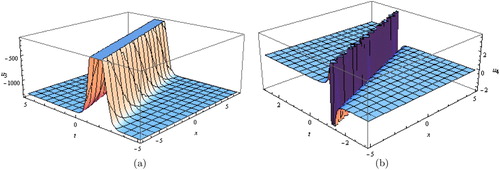
Figure 3. (a) Combined dark–bright soliton solutions for Equation (Equation20(20)
(20) ) and (b) bright soliton solutions for Equation (Equation21
(21)
(21) ).

Figure 4. (a) Dark soliton solution for Equation (Equation23(23)
(23) ) and (b) Kink wave soliton solution for Equation (Equation24
(24)
(24) ).
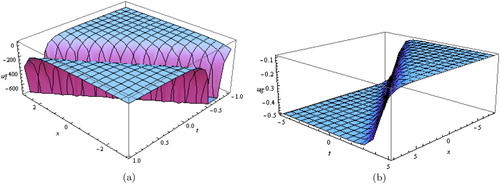
Figure 5. (a,b) Solitary wave solutions for Equation (Equation25(25)
(25) ) and Equation (Equation27
(27)
(27) ).

Figure 6. (a,b) Solitary traveling wave solutions for Equation (Equation28(28)
(28) ) and Equation (Equation29
(29)
(29) ).

Figure 7. (a) Solitary wave solution for Equation (Equation31(31)
(31) ) and (b) solitary traveling wave solution for Equation (Equation32
(32)
(32) ).
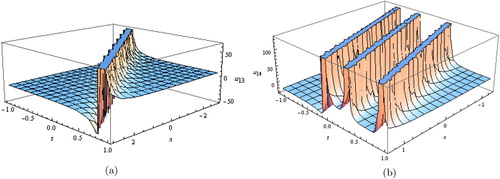
Figure 8. (a) Solitary traveling wave solution for Equation (Equation33(33)
(33) ) and (b) bright soliton solution for Equation (Equation36
(36)
(36) ).

Figure 9. (a) Solitary wave solutions for Equation (Equation37(37)
(37) ) and (b) bright soliton solution for Equation (Equation39
(39)
(39) ).
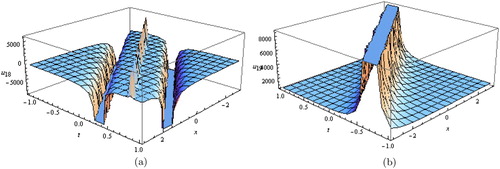
Figure 10. (a,b) Solitary wave solutions for Equation (Equation40(40)
(40) ) and Equation (Equation41
(41)
(41) ).
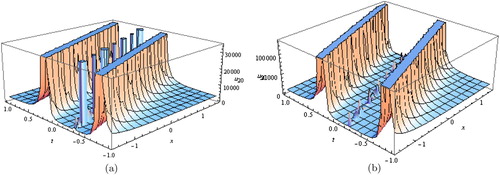
In Figure (a), dark soliton solution for Equation (Equation15(15)
(15) ) and (b) bright soliton solution for Equation (Equation16
(16)
(16) ), with these parameters values
. In Figure , 3D (a) bright soliton solution for Equation (Equation17
(17)
(17) ), and (b) dark soliton solution for Equation (Equation19
(19)
(19) ), with these parameters values
and
, respectively. In Figure (a), combined dark–bright soliton solutions for Equation (Equation20
(20)
(20) ) and (b) bright soliton solutions for Equation (Equation21
(21)
(21) ), with these parameters values
and
, respectively. In Figure (a), dark soliton solution for Equation (Equation23
(23)
(23) ) and (b) Kink wave soliton solution for Equation (Equation24
(24)
(24) ), with these parameters values
and
, respectively. In Figure (a,b), solitary wave solutions for Equation (Equation25
(25)
(25) ) and Equation (Equation27
(27)
(27) ), with these parameters values
and
, respectively. In Figure (a,b), solitary traveling wave solutions for Equation (Equation28
(28)
(28) ) and Equation (Equation29
(29)
(29) ), with these parameters values
and
, respectively. In Figure (a), solitary wave solution for Equation (Equation31
(31)
(31) ) and (b) Solitary traveling wave solution for Equation (Equation32
(32)
(32) ), with these parameters values
and
, respectively. In Figure (a), solitary traveling wave solution for Equation (Equation33
(33)
(33) ) and (b) bright soliton solution for Equation (Equation36
(36)
(36) ), with these parameters values
and
, respectively. In Figure (a), solitary wave solutions for Equation (Equation37
(37)
(37) ) and (b) bright soliton solution for Equation (Equation39
(39)
(39) ), with these parameters values
and
, respectively. In Figure (a,b), solitary wave solutions for Equation (Equation40
(40)
(40) ) and Equation (Equation41
(41)
(41) ), with these parameters values
and
, respectively.
We can conclude that from the above comparison and detailed discussion, our obtained solutions are new and more generally which have not formulated before by other techniques. It is proved that our modified technique is fruitful, reliable, straight forward and effective to investigate other nonlinear evolution equations.
5. Conclusion
We successfully constructed some new exact travelling and solitary wave solutions of nonlinear KS equation by applying the modified mathematical technique. Our solutions are different and new from other researcher found by using the different techniques before this work. Our new exact solutions obtained in the shape of dark solitons, bright solitons, travelling wave, solitary wave and periodic wave. These new solutions are more useful in the study of quantum plasma, optical fibres, dynamics of solitons, dynamics of fluid, problems of biomedical, mathematical physics, engineering and many other branches. The physical structure of new solutions shows the effectiveness and power of this technique. This research work completed by using the Mathematica. We can also apply this technique on other nonlinear evolution equations involves in optical fibre, Geo physics, mathematical physics, plasma physics, fluid dynamics, hydrodynamics, mechanics, mathematical biology, field of engineering and many other applied sciences.
Disclosure statement
No potential conflict of interest was reported by the authors.
ORCID
Aly R. Seadawy http://orcid.org/0000-0002-7412-4773
Mujahid Iqbal http://orcid.org/0000-0003-1234-4321
References
- Kudryashov NA, Sinelshchikov DI. Nonlinear wave in bubbly liquids with consideration for viscosity and heat transfer. Phys Lett A. 2010;374:2011–2016. doi: 10.1016/j.physleta.2010.02.067
- Korteveg DJ, De Vries G. On the change of long waves advancing in a rectangular canal and on new type of long stationary waves. Philos Mag. 1895;39:422–443. doi: 10.1080/14786449508620739
- Shu JJ. The proper analytical solution of the Korteweg-de Vries-Burgers equation. J Phys A Math Gen. 1987;20:49–56. doi: 10.1088/0305-4470/20/2/002
- Ryabov PN, Sinelshchikov DI, Kochanov MB. Application of the Kudryashov method for finding exact solutions of the high order nonlinear evolution equation. Appl Math Comput. 2011;218:3965–3972.
- Li J, Chen G. Exact traveling wave solutions and their bifurcations for the Kudryashov-Sinelshchikov equation. Int J Bifurc Chaos Appl Sci Eng. 2012;22:1250118.
- Randrt M. On the Kudryashov–Sinelshchikov equation for waves in bubbly liquids. Phys Lett A. 2011;375:3687–3692. doi: 10.1016/j.physleta.2011.08.048
- Seadawy AR, Lu D, Yue C. Travelling wave solutions of the generalized nonlinear fifth-order KdV water wave equations and its stability. J Taibah Univ Sci. 2017;11:623–633. doi: 10.1016/j.jtusci.2016.06.002
- He B, Meng Q, Long Y. The bifurcation and exact peakons, solitary and periodic wave solutions for the Kudryashov-Sinelshchikov equation. Commun Nonlinear Sci Numer Simul. 2012;17:4137–4148. doi: 10.1016/j.cnsns.2012.03.007
- Yang H, Liu W, Yang B, et al. Lie symmetry analysis and exact explicit solutions of three-dimensional Kudryashov-Sinelshchikov equation. Commun Nonlinear Sci Numer Simul. 2015;27:271–280. doi: 10.1016/j.cnsns.2015.03.014
- Zhao YM. F-expansion method and its application for finding new exact solutions to the Kudryashov-Sinelshchikov equation. J Appl Math. 2013;2013:1–7.
- Tian SF. Initial-boundary value problems for the general coupled nonlinear Schrodinger equation on the interval via the Fokas method. J Differ Equ. 2017;262(1):506–558. doi: 10.1016/j.jde.2016.09.033
- Tian SF. The mixed coupled nonlinear Schrödinger equation on the half-line via the Fokas method. Proc R Soc A. 2016;472(2195):20160588. doi: 10.1098/rspa.2016.0588
- Tian SF. Initial-boundary value problems of the coupled modified Korteweg-de Vries equation on the half-line via the Fokas method. J Phys A Math Theor. 2017;50(39):395204. doi: 10.1088/1751-8121/aa825b
- Tian SF, Zhang TT. Long-time asymptotic behavior for the Gerdjikov-Ivanov type of derivative nonlinear Schrödinger equation with time-periodic boundary condition. Proc Am Math Soc. 2018;146(4):1713–1729. doi: 10.1090/proc/13917
- Tian SF. Initial-boundary value problems for the coupled modified Korteweg-de Vries equation on the interval. Commun Pure Appl Anal. 2018;17(3):923–957. doi: 10.3934/cpaa.2018046
- Tian SF. Infinite propagation speed of a weakly dissipative modified two-component Dullin-Gottwald-Holm system. Appl Math Lett. 2019;89:1–7. doi: 10.1016/j.aml.2018.09.010
- Yan XW, Tian SF, Dong MJ, et al. Rogue waves and their dynamics on Bright-Dark soliton background of the coupled higher order nonlinear Schrodinger equation. J Phys Soc Japan. 2019;88(7):074004. doi: 10.7566/JPSJ.88.074004
- Guo D, Tian SF, Zhang TT. Integrability, soliton solutions and modulation instability analysis of a (2+ 1)-dimensional nonlinear Heisenberg ferromagnetic spin chain equation. Comput Math Appl. 2019;77(3):770–778. doi: 10.1016/j.camwa.2018.10.017
- Peng WQ, Tian SF, Zhang TT. Analysis on lump, lumpoff and rogue waves with predictability to the (2+ 1)-dimensional B-type Kadomtsev-Petviashvili equation. Phys Lett A. 2018;382(38):2701–2708. doi: 10.1016/j.physleta.2018.08.002
- Wang XB, Tian SF, Feng LL, et al. On quasi-periodic waves and rogue waves to the (4+ 1)-dimensional nonlinear Fokas equation. J Math Phys. 2018;59(7):073505. doi: 10.1063/1.5046691
- Yan XW, Tian SF, Dong MJ, et al. Characteristics of solitary wave, homoclinic breather wave and rogue wave solutions in a (2+ 1)-dimensional generalized breaking soliton equation. Comput Math Appl. 2018;76(1):179–186. doi: 10.1016/j.camwa.2018.04.013
- Qin CY, Tian SF, Wang XB, et al. Rogue waves, bright-dark solitons and traveling wave solutions of the (3+ 1)-dimensional generalized Kadomtsev-Petviashvili equation. Comput Math Appl. 2018;75(12):4221–4231. doi: 10.1016/j.camwa.2018.03.024
- Ahmed I, Seadawy AR, Lu D. Kinky breathers, W-shaped and multi-peak solitons interaction in (2+ 1)-dimensional nonlinear Schrodinger equation with Kerr law of nonlinearity. Eur Phys J Plus. 2019;134:120. doi: 10.1140/epjp/i2019-12482-8
- Seadawy AR, Manafian J. New soliton solution to the longitudinal wave equation in a magneto-electro-elastic circular rod. Results Phys. 2018;8:1158–1167. doi: 10.1016/j.rinp.2018.01.062
- Lu D, Seadawy AR, Ali A. Applications of exact traveling wave solutions of modified Liouville and the symmetric regularized long wave equations via two new techniques. Results Phys. 2018;9:1403–1410. doi: 10.1016/j.rinp.2018.04.039
- Juan L, Xu T, Meng XH, et al. Lax pair, Backlund transformation and N-soliton-like solution for a variable-coefficient Gardner equation from nonlinear lattice, plasma physics and ocean dynamics with symbolic computation. J Math Anal Appl. 2007;336:1443–1455. doi: 10.1016/j.jmaa.2007.03.064
- Seadawy AR, El-Rashidy K. Traveling wave solutions for some coupled nonlinear evolution equations. Math Comput Model. 2013;57:1371–1379. doi: 10.1016/j.mcm.2012.11.026
- Seadawy AR, Lu D. Ion acoustic solitary wave solutions of three-dimensional nonlinear extended Zakharov–Kuznetsov dynamical equation in a magnetized two-ion-temperature dusty plasma. Results Phys. 2016;6:590–593. doi: 10.1016/j.rinp.2016.08.023
- Seadawy AR. The solutions of the boussinesq and generalized Fifth-Order KdV equations by using the direct algebraic method. Appl Math Sci. 2012;82:4081–4090.
- Iqbal M, Seadawy AR, Lu D. Construction of solitary wave solutions to the nonlinear modified Kortewege-de Vries dynamical equation in unmagnetized plasma via mathematical methods. Mod Phys Lett A. 2018;33:1–13.
- Iqbal M, Seadawy AR, Lu D. Dispersive solitary wave solutions of nonlinear further modified Kortewege-de Vries dynamical equation in a unmagnetized dusty plasma via mathematical methods. Mod Phys Lett A. 2018;33:1–19.
- Seadawy AR, Lu D, Iqbal M. Application of mathematical methods on the system of dynamical equations for the ion sound and Langmuir waves. Pramana J Phys. 2019;93:1–10. doi: 10.1007/s12043-019-1771-x
- Iqbal M, Seadawy AR, Lu D. Applications of nonlinear longitudinal wave equation in a magneto-electro-elastic circular rod and new solitary wave solutions. Mod Phys Lett B. 2019;33:1950210. doi: 10.1142/S0217984919502105
- Seadawy AR. Stability analysis for Zakharov–Kuznetsov equation of weakly nonlinear ion-acoustic waves in a plasma. Comput Math Appl. 2014;67:172–180. doi: 10.1016/j.camwa.2013.11.001
- Seadawy AR. Stability analysis for two-dimensional ion-acoustic waves in quantum plasmas. Phys Plasma. 2014;21:052107. doi: 10.1063/1.4875987
- Seadawy AR. Approximation solutions of derivative nonlinear Schrodinger equation with computational applications by variational method. Eur Phys J Plus. 2015;130:182. doi: 10.1140/epjp/i2015-15182-5
- Seadawy AR. Nonlinear wave solutions of the three-dimensional Zakharov–Kuznetsov–Burgers equation in dusty plasma. Phys A Stat Mech Appl. 2015;439:124–131. doi: 10.1016/j.physa.2015.07.025
- Seadawy AR. Ion acoustic solitary wave solutions of two-dimensional nonlinear Kadomtsev-Petviashvili-Burgers equation in quantum plasma. Math Methods Appl Sci. 2017;40:1598–1607. doi: 10.1002/mma.4081
- Seadawy AR. Three-dimensional nonlinear modified Zakharov–Kuznetsov equation of ion-acoustic waves in a magnetized plasma. Comput Math Appl. 2016;71:201–212. doi: 10.1016/j.camwa.2015.11.006
- Seadawy AR. Solitary wave solutions of two-dimensional nonlinear Kadomtsev–Petviashvili dynamic equation in dust-acoustic plasmas. Pramana J Phys. 2017;89:49. doi: 10.1007/s12043-017-1446-4
- Seadawy AR, El-Rashidy K. Water wave solutions of the coupled system Zakharov-Kuznetsov and generalized coupled KdV equations. Sci World J. 2014;2014:1–6. doi: 10.1155/2014/724759
- Yaro D, Seadawy AR, Lu D, et al. Dispersive wave solutions of the nonlinear fractional Zakhorov-Kuznetsov-Benjamin-Bona-Mahony equation and fractional symmetric regularized long wave equation. Results Phys. 2019;12:1971–1979. doi: 10.1016/j.rinp.2019.02.005
- Lu D, Seadawy AR, Iqbal M. Mathematical physics via construction of traveling and solitary wave solutions of three coupled system of nonlinear partial differential equations and their applications. Results Phys. 2018;11:1161–1171. doi: 10.1016/j.rinp.2018.11.014
- Lu D, Seadawy AR, Iqbal M. Construction of new solitary wave solutions of generalized Zakharov-Kuznetsov-Benjamin-Bona-Mahony and simplified modified form of Camassa-Holm equations. Open Phys. 2018;16:896–909. doi: 10.1515/phys-2018-0111
- Seadawy AR, Iqbal M, Lu D. Propagation of long-wave with dissipation and dispersion in nonlinear media via generalized Kadomtsive-Petviashvili modified equal width-Burgers equation. Ind J Phys. 2019. doi:10.1007/s12648-019-01500-z
- Seadawy AR, Iqbal M, Lu D. Applications of propagation of long-wave with dissipation and dispersion in nonlinear media via solitary wave solutions of generalized Kadomtsev–Petviashvili modified equal width dynamical equation. Comput Math Appl. 2019. doi:10.1016/j.camwa.2019.06.013.
- Seadawy AR, El-Rashidy K. Rayleigh-Taylor instability of the cylindrical flow with mass and heat transfer. Pramana J Phys. 2016;87:20. doi: 10.1007/s12043-016-1222-x
- Seadawy AR, Iqbal M, Lu D. Construction of soliton solutions of the modify unstable nonlinear Schrödinger dynamical equation in fiber optics. Ind J Phys. 2019. doi:10.1007/s12648-019-01532-5
- Tariq KU-H, Seadawy A. Bistable Bright-Dark solitary wave solutions of the (3+1)-dimensional breaking soliton, Boussinesq equation with dual dispersion and modified Korteweg-de Vries-Kadomtsev-Petviashvili equations and their applications. Results Phys. 2017;7:1143–1149. doi: 10.1016/j.rinp.2017.03.001
- Seadawy A. Two-dimensional interaction of a shear flow with a free surface in a stratified fluid and its a solitary wave solutions via mathematical methods. Eur Phys J Plus. 2017;132:518. doi: 10.1140/epjp/i2017-11755-6
